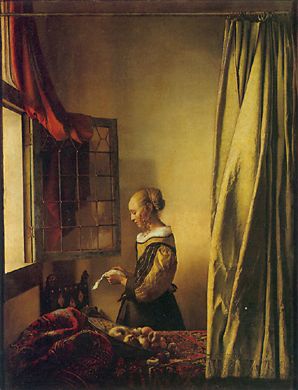TOM HUNTER
I have been looking at some photographers that have taken influence from famous paintings, in particular Pre Raphealite work.In particular, I have been looking at Tom Hunter who created a series of images that reflected the paintings of the same era I will be looking at.
Above is an example of one of his images, the title of this image is ' Woman Reading Possession Order,' and it was taken in 1998. Hunter photographs the people and places of his immediate community. The image above is part of a series of work he made of a group of squatters living in Hackney, London. In this photo, Hunter borrows his composition and colour choices ferom Vermeer's A Girl Reading A Letter At An Open Window, painted in 1657. Like Vermeer, Hunter portrays quiet, everyday scenes which gives his 'outsider' subjects a visible presence.
I have taken a lot of inspiration from his work and really enjoy the way he ties in modern issues, whilst still using similiarties of the original painting to recreate his narrative.


Analysis of image
Similiarily to Hunter, I aim to use natural lighting from the window to create the same effect as my painting. I particularly like the choice of lighting in the photograph, the womans face is lit up as well as the babies, which could symbolise the coice that she now has to make, and the feeling of possibly being exposed and found out for squatting. Hunter used a large format camera for this image, which he claims helped to capture the light, and used superchrome process to print it. Tom Hunter used a personal situation to him, much like the Pre-Raphealites did for their paintings. Hunter was inspired by Dutch painting, but mainly by the situation his friends were in at the time. The image was inspired by real life situations, and what was going on at the time politically. The squatters on the street were being threatened to leave, and his neighbour, the model in the image, had a new born baby. This narrative was very true to life, which is what I will take inspiration from, I really like this technique as it brings a personal touch to the images.
'' The 17th-century golden age of Dutch painting had had a massive impact on me: the way they dealt with ordinary people, not kings, queens and generals. I thought if I could borrow their style for squatters and travellers, it would elevate their status. In this shot, inspired by Vermeer's Girl Reading a Letter at an Open Window, my next-door neighbour is reading the possession order.''
Quote from Tom Hunter about the photograph for the Guardian.


Above is another example of Tom Hunters recreation of artwork. Again, this is another example of Hunter taking inspiration from historical narratives and paintings, but instead including more modern day social issues, adding a raw and edgier twist to the images. Hunter's work seems to feature strong green hues, which allows his work to transcend the normality of conventional colour photography to giving it a painting effect.
The painting by John Everett Millais was recreated by Hunter; in a completely modern context. The story behind Ophelia, is taken from Hamlet. Ophelia who through the death of her father and brother is driven to madness, and drowns herself. The emotion is meant to be one of not only sorrow but of sympathy; the character of ophelia is presented as one of innocence, reservation and simplicity; her madness was something bought on by her irrationality and her circumstance. Millais tries to capture this through her expression on her face as she lies in the water; her arms poised in a helpless manner: almost as if to say woe is me.
Hunter rekindles many of these concepts within his work; but makes the image realistic within the 21st century. The model is deliberately wearing “modern” or clothing synonymous with the 21st century. One of the most powerful elements of this image as a modern recreation, is the train bridge in the background; although very subtle, it completely changes the context of the image, and brings the scene ‘back to reality”. The emotion in Ophelia’s face and expression has been removed by hunter; here he composes her almost as if she is dead: pale and motionless. This brings to mind the element of a sinister death as opposed to a sympathetic peaceful one.
No comments:
Post a Comment